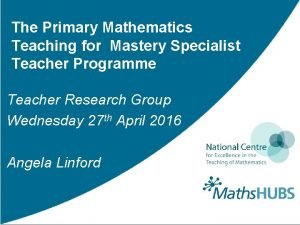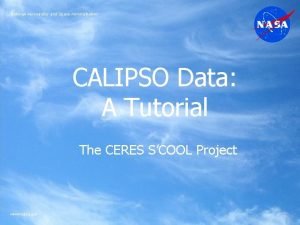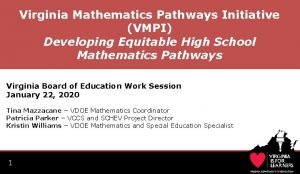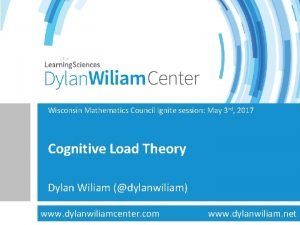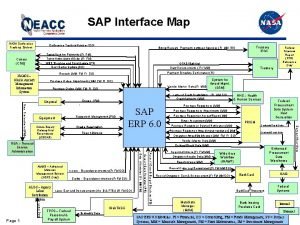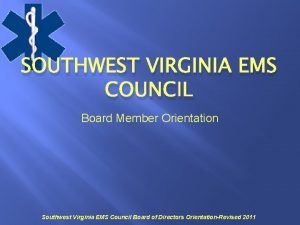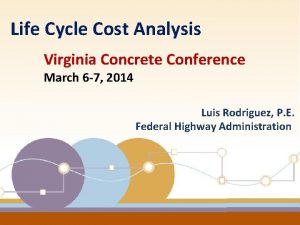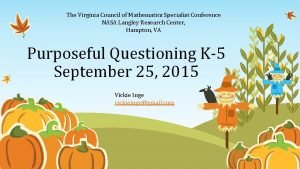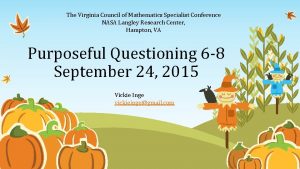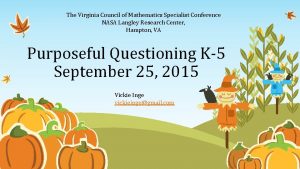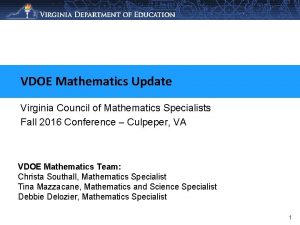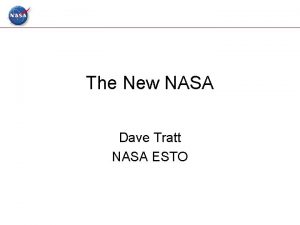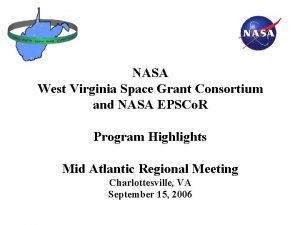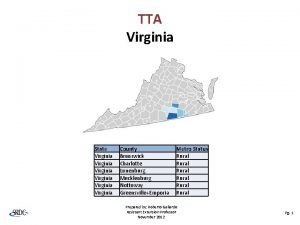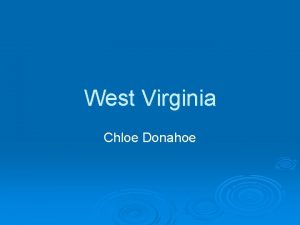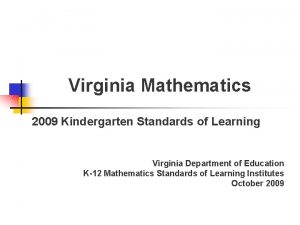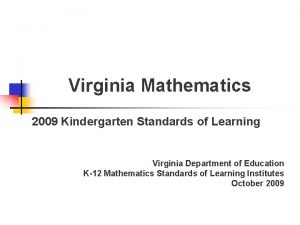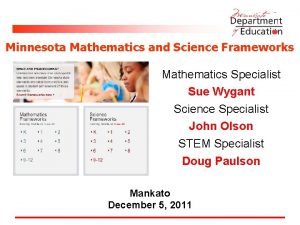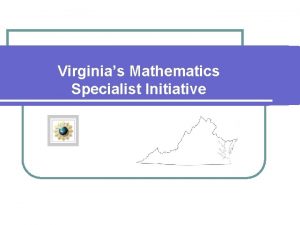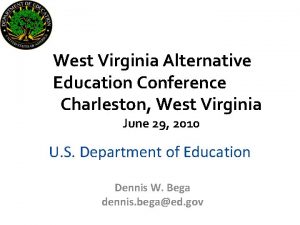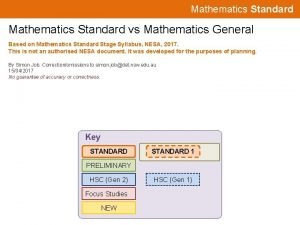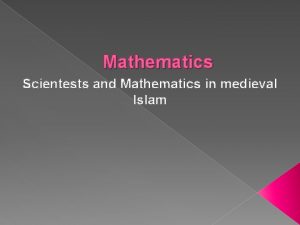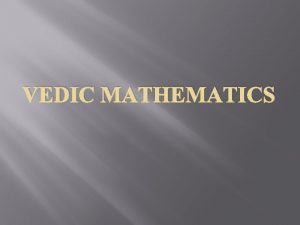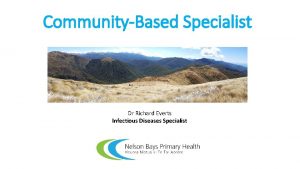The Virginia Council of Mathematics Specialist Conference NASA


























- Slides: 26

The Virginia Council of Mathematics Specialist Conference NASA Langley Research Center, Hampton, VA Purposeful Questioning 6 -8 September 24, 2015 Vickie Inge vickieinge@gmail. com

Overview of the Session • Examining the types of questions and the patterns of questioning teachers use in the classroom. • Watch video clips of an 8 th grade pre-algebra class working on the Calling Plans Task. • Relate teacher and student actions in the video to the effective teacher and student actions as well as the types of questions for purposeful questioning. • Consider how to support teachers in using purposeful questioning.

Effective NCTM, Principles to Actions, p. 10

Question Sort • Open the envelop on your table and work as table groups to sort the questions into exactly 4 non-overlapping groups or sets. • Analyze the type of engagement and thinking each set brings out in the class room and develop a word or phrase that could be used to categorize the type of questions in each set.

Making Sense of Mathematics An excellent mathematics program requires effective teaching that engages students in meaningful learning through individual and collaborative experiences that promote their ability to make sense of mathematical ideas and reason mathematically. National Council of Teachers of Mathematics. (2014). Principles to actions: Ensuring mathematical success for all. Reston, VA: Author. (p. 7) Teachers’ questions are crucial in helping students make connections and learn important mathematics concepts. Teachers need to know how students typically think about particular concepts, how to determine what a particular student or group of students thinks about those ideas, and how to help students deepen their understanding. Weiss & Pasley, 2004

Overview of the Relationship Between Question Types and Patterns of Questioning Table, HO page 3 • In the 2 nd Column you will see the identifying name for each type of question that the authors of Principles to Actions: Ensuring Mathematical Success for All use. • Column 3 provides a description or purpose of each type of question. • Column 4 provides examples of specific questions representing each type. • Column 1 identifies the two patterns of questioning observed in most classrooms and the set up of the table suggests the type of question that typically is used in each pattern. Work with a partner to explore the information contained in he table.

Principles to Actions Professional Learning Toolkit Website with Resources http: //www. nctm. org/ptatoolkit

Ms. Bovery’s Mathematics Learning Goals Students will understand that: 1. the point of intersection is a solution to each equation (Companies A, B, and C); 2. the rate of change (cost per minute) determines the steepness of the line; 3. if the y-intercept (monthly base rate) is lowered then the rate of change (cost per minute) must increase in order for the new equation to intersect the other two at the same point.

The Calling Plans Task Long-distance company A charges a base rate of $5. 00 per month plus 4 cents for each minute that you are on the phone. Longdistance company B charges a base rate of only $2. 00 per month but charges you 10 cents for every minute used. • Part 1: How much time per month would you have to talk on the phone before subscribing to company A would save you money? • Part 2: Create a phone plane, Company C, that costs the same as Companies A and B at 50 minutes, but has a lower monthly fee than either Company A or B.

Pose Purposeful Questions Effective Questions should: • Reveal students’ current understandings; • Encourage students to explain, elaborate, or clarify their thinking; and • Make the mathematics more visible and accessible for student examination and discussion.

Pose Purposeful Questions Teacher and Student Actions (HO page 2) What are teachers doing? What are students doing? • Advancing student understanding by asking questions that build on, but do not take over or funnel, student thinking. • Making certain to ask questions that go beyond gathering information to probing thinking and requiring explanation and justification. • Asking intentional questions that make the mathematics more visible and accessible for student examination and discussion. • Allowing sufficient wait time so that more students can formulate and offer responses. • Expecting to be asked to explain, clarify, and elaborate on their thinking. • Thinking carefully about how to present their responses to questions clearly, without rushing to respond quickly. • Reflecting on and justifying their reasoning, not simply providing answers. • Listening to, commenting on, and questioning the contributions of their classmates.

The Calling Plans Task – Part 2 The Context of Video Clip 1 • Prior to the lesson: • Students solved the Calling Plans Task – Part 1. • The tables, graphs and equations they produced in response to that task were posted in the classroom. • Video Clip 1 begins immediately after Mrs. Brovey explained that students would be working on the Calling Plans Task – Part 2 and read the problem to students. Students first worked individually and subsequently worked in small groups.

Lens for Watching Video Clip 1 As you watch the first video clip, pay attention to the teacher and student indicators associated with Pose Purposeful Questioning. Think About’s: • What types of questions is the teacher using? • What can you say about the pattern of questions? • What do you notice about the student actions?

Managing Effective Student Discourse • Why is high level classroom discourse so difficult to facilitate? • What knowledge and skills are needed to facilitate productive discourse? • Why is it important? (i. e. Why do we care? )

Questioning Techniques • Funneling Questions • Focusing Questions • How many sides does that shape have? • What have you figured out? • Is this angle larger? • Does that always work? If yes, why? If not, why not? When not? • What is the product? • Why do you think that? • Is there another way? • How are these two methods different? How are they similar?

Questioning: Funneling or Focusing • Funneling occurs when a teacher asks a series of questions to guide students through a procedure or to a desired result. • Teacher engages in cognitive activity • Student merely answering questions – often without seeing connections

Questioning: Funneling or Focusing • Focusing requires the teacher to listen to student responses and guide them based on what students are thinking rather than how the teacher would solve the problem. • Allows teacher to learn about student thinking • Requires students to articulate their thinking • Promotes making connections

“Our goal is not to increase the amount of talk in our classrooms, but to increase the amount of high quality talk in our classrooms—the mathematical productive talk. ” –Classroom Discussions: Using Math Talk to Help Students Learn, 2009

Planning for Mathematical Discussion Productive Talk Formats What do We Talk About 1. Whole-Class Discussion 1. Mathematical Concepts 2. Small-Group Discussion 2. Computational Procedures 3. Partner Talk What Do We Talk About? 3. Solution Methods and Problem. Solving Strategies 4. Mathematical Reasoning 5. Mathematical Terminology, Symbols, and Definitions 6. Forms of Representation Chapin S. , O’Connor, C. , & Canavan Anderson, N. (2003). Classroom discussions: Using math talk to help students learn. Sausalito, CA: Math Solutions.

A survey of multiple studies on questioning support the following: • Plan relevant questions directly related to the concept or skill being taught. • Phrase questions clearly to communicate what the teacher expects of the intent and quality of students’ responses. • Do not direct the question to anyone until after it is asked so that all students pay attention. • Allow adequate wait time to provide students time to think before responding. • Encourage and design for wide student participation.

Bridging to Practice How can we support teachers in purposeful questioning. (HO 7)

Bridging to Practice Analyzing the Challenging Situation 1. My students will not talk 2. The same few kids do all the talking 3. Should I call on students who _______ 4. My students will talk, but they will not listen 5. What to do if students provide a response I do not understand 6. I have students at different levels 7. What to do when students are wrong 8. The discussion is not going anywhere--or at least not where I planned 9. Answers or responses are superficial 10. What if the first speaker gives the right answer 11. What to do for English Language Learners Some Ideas for Trouble Shooting Challenges

Change is Not Easy or Comfortable 26

Support—Support--Support Come on team we can do this together for the good of the students! OR 27

Resources Chapin S. , O’Connor, C. , & Canavan Anderson, N. (2003). Classroom discussions: Using math talk to help students learn. Sausalito, CA: Math Solutions. Huinker, D. , & Freckmann, J. L. (2004). Focusing conversations to promote teacher thinking. Teaching Children Mathematics, 10(7) 352 -357. National Council of Teachers of Mathematics. (2014). Principles to Actions: Ensuring Mathematical Success for All. Reston, VA: National Council of Teachers of Mathematics. (n. d. ) Principles to Actions Professional Learning Toolkit. Retrieved September 2015. From http: //www. nctm. org/ptatoolkit/. Reinhart, S. D. (2000). Never say anything a kid can say. Mathematics Teaching in the Middle School, 5(8) 478– 483.

Resources Sullivan, P. , & Lilburn, P. (2002). Good questions for math teaching: Why ask them and what to ask. Grades K-6. Sausalito, CA: Math Solutions. Schuster, L. , & Anderson, N. C. (2005). Good Questions for math teaching: Why ask them and what to ask. Grades 5 -8. Sausalito, CA: Math Solutions. Small, M. (2012). Good Questions – Great Ways to Differentiate Mathematics Instruction. New York, NY: Teachers College Press. Smith, M. S. , & Stein, M. K. (2011). 5 Practices for Orchestrating Productive Mathematics Discussions. Reston, VA: National Council of Teachers of Mathematics and Thousand Oaks, CA: Corwin Press. Smith, M. S. , Hughes, E. K. , & Engle, R. A. , & Stein, M. K. (2009). Orchestrating discussions. Mathematics Teaching in the Middle School, 14 (9), 549 -556.
 Primary mathematics specialist teacher programme
Primary mathematics specialist teacher programme Halimbawa ng awit sa panitikan
Halimbawa ng awit sa panitikan Nasa www.nasa.gov
Nasa www.nasa.gov Virginia math pathways initiative
Virginia math pathways initiative Element interactivity
Element interactivity Nasa conference tracking system
Nasa conference tracking system Seo northern virginia virginia
Seo northern virginia virginia Southwest virginia ems council
Southwest virginia ems council Virginia concrete conference
Virginia concrete conference Từ ngữ thể hiện lòng nhân hậu
Từ ngữ thể hiện lòng nhân hậu Diễn thế sinh thái là
Diễn thế sinh thái là Vẽ hình chiếu vuông góc của vật thể sau
Vẽ hình chiếu vuông góc của vật thể sau Lp html
Lp html Thế nào là giọng cùng tên
Thế nào là giọng cùng tên Làm thế nào để 102-1=99
Làm thế nào để 102-1=99 Chúa yêu trần thế
Chúa yêu trần thế Lời thề hippocrates
Lời thề hippocrates Khi nào hổ con có thể sống độc lập
Khi nào hổ con có thể sống độc lập Glasgow thang điểm
Glasgow thang điểm đại từ thay thế
đại từ thay thế Quá trình desamine hóa có thể tạo ra
Quá trình desamine hóa có thể tạo ra Công thức tính độ biến thiên đông lượng
Công thức tính độ biến thiên đông lượng Thế nào là mạng điện lắp đặt kiểu nổi
Thế nào là mạng điện lắp đặt kiểu nổi Dạng đột biến một nhiễm là
Dạng đột biến một nhiễm là Bổ thể
Bổ thể Vẽ hình chiếu đứng bằng cạnh của vật thể
Vẽ hình chiếu đứng bằng cạnh của vật thể Phản ứng thế ankan
Phản ứng thế ankan
